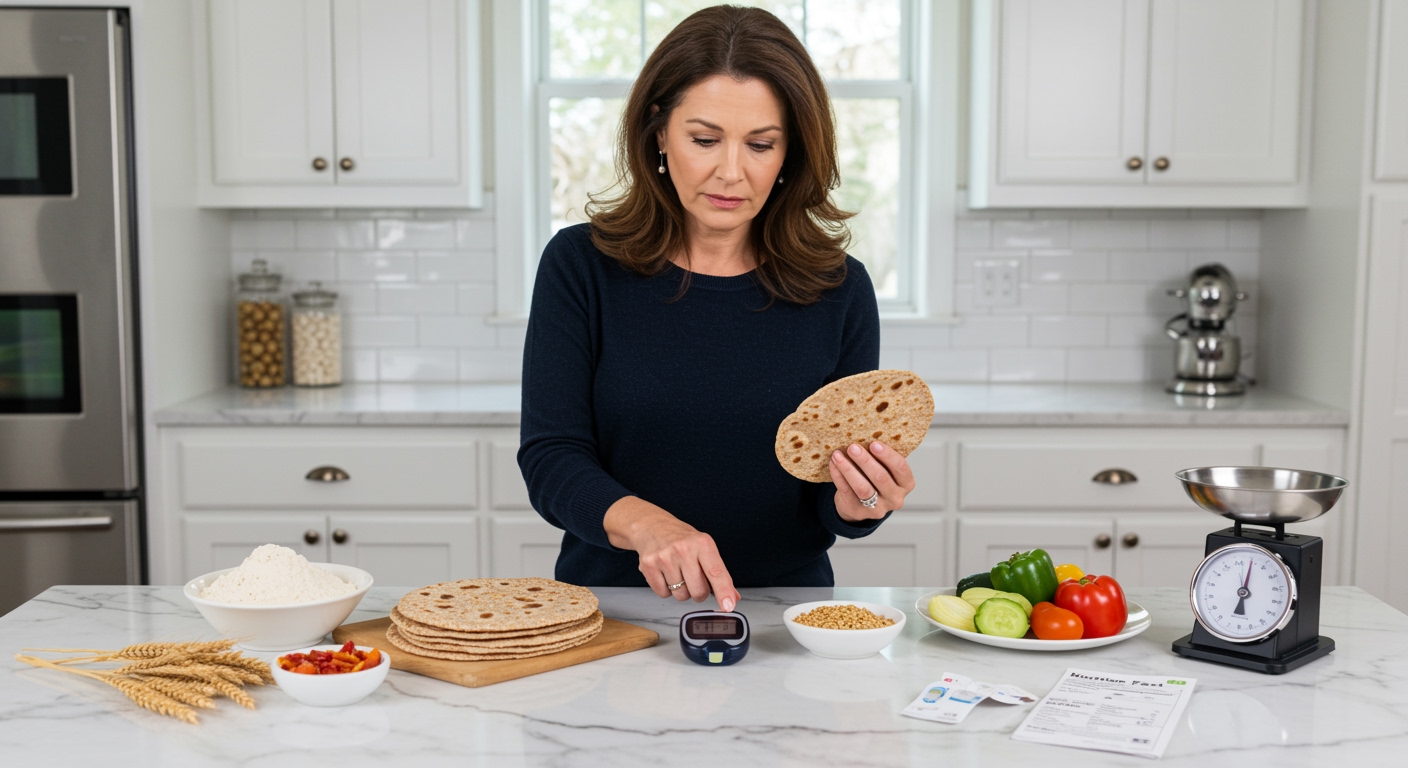✪ Key Takeaway: Chapati can be part of a diabetic diet when made with whole wheat flour and eaten in controlled portions with protein and fiber.
Introduction
Your doctor just told you that you have diabetes and now you are staring at your favorite chapati wondering if you can ever eat it again.
You might be asking this question because chapati is a staple food in many households and giving it up seems impossible.
Hi, I am Abdur, your nutrition coach and today I am going to explain whether chapati is good for diabetes and how you can include it safely in your meal plan.
What Happens When You Eat Chapati With Diabetes?
When you eat chapati, your body breaks down the carbohydrates into glucose which enters your bloodstream.
The glycemic index of whole wheat chapati ranges from 62 to 72, which puts it in the medium to high category.
Your pancreas releases insulin to help cells absorb this glucose for energy.
However, if you have diabetes, your body either does not produce enough insulin or cannot use it effectively.
This means the glucose from chapati can cause your blood sugar levels to rise higher than normal.
The speed and extent of this rise depends on several factors including the type of flour used, portion size, and what you eat with the chapati.
Research shows that whole wheat chapati causes a more gradual blood sugar rise compared to refined flour chapati because of its higher fiber content.
✪ Fact: One medium chapati contains about 15-20 grams of carbohydrates, equivalent to one bread slice.
Which Type Of Chapati Is Better For Diabetics?
The type of flour you choose makes a huge difference in how chapati affects your blood sugar.
Whole wheat flour chapati is your best option because it contains the entire grain including the bran and germ.
This means you get more fiber, protein, and nutrients that help slow down glucose absorption.
Refined flour chapati, on the other hand, has been stripped of these beneficial components and will cause faster blood sugar spikes.
You can also try multigrain chapati made with a mix of whole wheat, oats, barley, and other grains.
These alternatives provide even more fiber and have a lower glycemic impact.
Some people find success with chapati made from almond flour or coconut flour, though these have different textures and nutritional profiles.
✪ Pro Tip: Add ground flaxseed or psyllium husk to your chapati dough for extra fiber and better blood sugar control.
How Many Chapatis Can A Diabetic Eat Per Day?
The number of chapatis you can eat depends on your individual blood sugar response, activity level, and overall meal plan.
Most diabetes educators recommend starting with one to two small chapatis per meal and monitoring your blood sugar response.
A small chapati is about 6 inches in diameter and contains roughly 15 grams of carbohydrates.
Your total daily carbohydrate intake should typically range from 45 to 65 percent of your total calories, but this varies based on your diabetes management plan.
If you are following a low-carb approach, you might limit yourself to one chapati per day or every other day.
The key is to test your blood sugar before and after eating to understand how chapati affects you personally.
Some people can handle more chapatis if they are very active or have well-controlled diabetes, while others need to be more restrictive.
✪ Note: Your diabetes medication timing and dosage may need adjustment when you change your chapati consumption.
What Should You Eat With Chapati To Control Blood Sugar?
What you eat with your chapati is just as important as the chapati itself for managing blood sugar levels.
Protein sources like dal, chicken, fish, or paneer help slow down carbohydrate absorption and provide satiety.
Adding plenty of non-starchy vegetables like spinach, cauliflower, broccoli, or bell peppers increases fiber and nutrients without adding many carbs.
Healthy fats from sources like olive oil, nuts, or avocado can also help moderate the blood sugar response.
The plate method works well here: fill half your plate with vegetables, one quarter with protein, and one quarter with chapati.
Eating your vegetables and protein first, then the chapati, can help minimize blood sugar spikes.
Avoid pairing chapati with other high-carb foods like rice, potatoes, or sugary drinks as this will cause excessive blood sugar elevation.
✪ Pro Tip: Drink a glass of water with a tablespoon of apple cider vinegar before meals to help improve insulin sensitivity.
When Is The Best Time To Eat Chapati If You Have Diabetes?
Timing your chapati consumption can significantly impact your blood sugar management throughout the day.
Morning and lunch are generally better times to eat chapati because your body is more insulin sensitive earlier in the day.
Your metabolism is also higher during these times, which means you are more likely to use the glucose for energy rather than storing it.
Eating chapati at dinner can be problematic because insulin sensitivity naturally decreases in the evening.
If you must eat chapati at night, make it smaller and pair it with extra protein and vegetables.
Consider your physical activity schedule when planning chapati consumption.
Eating chapati before exercise can provide energy for your workout and help prevent post-meal blood sugar spikes.
The Bottom Line
Chapati can be part of a healthy diabetic diet when you choose whole wheat varieties, control portions, and pair them with protein and vegetables.
Smart food choices are not about elimination but about making informed decisions that support your health goals.
I would love to hear about your experience with chapati and diabetes management, so please share your questions or feedback in the comments section below.
References
At NutritionCrown, we use quality and credible sources to ensure our content is accurate and trustworthy. Below are the sources referenced in creating this article:
- January AI: Chapati Glycemic Index
- SugarFit: Is Wheat Chapati Good for Diabetes
- Ultrahuman: Eating Chapati the Right Way
- Diabesmart: Glycemic Index of Roti





